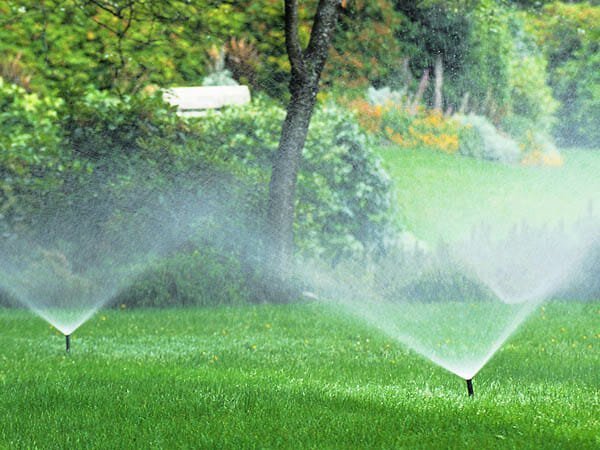
So You Want a Lawn
So You Want a Lawn
By: Dr. Leonard Perry, Extension Professor
University of Vermont
 Bare spots from foot or vehicle traffic, bare earth left after new building or landscape construction, former garden beds, or overgrown weedy areas you’ve cleared out, are all sites where you may want to establish a new lawn. Proper site preparation, including soil amendments, choosing the right grass varieties, and then proper planting and aftercare are the keys to establishing a healthy lawn.
Bare spots from foot or vehicle traffic, bare earth left after new building or landscape construction, former garden beds, or overgrown weedy areas you’ve cleared out, are all sites where you may want to establish a new lawn. Proper site preparation, including soil amendments, choosing the right grass varieties, and then proper planting and aftercare are the keys to establishing a healthy lawn.
The first step is to consider if a lawn is even appropriate. If water is a limiting resource, or you want to conserve water, then less lawn might be for you. Garden beds, shrubs, trees, or simply other groundcover plants (usually herbaceous perennials like thyme, foamflower, carpet bugle, or Japanese spurge) all require less water to remain healthy than lawns.
If certain areas will get lots of foot traffic, consider paths. Mulch might be a good choice for a natural, shady area or where traffic is light and occasional. Gravel might work for sunny areas with light traffic, but get small paving mixes rather than larger pebbles. The latter will be hard to walk on and even harder to push a cart. Paved surfaces are best for the latter, or for heavy traffic as between a drive and door entrance. Play areas, such as under swing sets, are best covered in sand. If this gets into adjacent lawn areas, simply use a shop vacuum to suck it up and then redeposit where desired.
Although there are some grasses that will tolerate part shade, for these or deep shade (under 4 hours per day direct sun) you may want to consider groundcovers. For wet sites you’ll need to invest in drainage pipes and extensive soil amendments. Easier might be to just install a garden bed with shrub dogwood, Siberian iris, or other plants that tolerate wet soils.
Once you’ve decided that having a lawn is appropriate, choose the seeds. Figure how much square feet will be covered to buy sufficient (or not too many) seeds. Most grass seed you find will be in bags labeled with how much area the bag will cover. If buying seeds in bulk, figure on one to 2 pounds per 1000 square feet for Kentucky bluegrasses, 2 to 4 pounds for bluegrass-fescue mixes, or 6 to 8 pounds for tall fescue.
So what are these grass types, and why is this important? Grass types vary in how much wear or foot traffic they will take, as well as temperature and light. There are grasses for cool and warm climates. Kentucky bluegrass and fine fescue are good choices for cool seasons and sun (over 6 hours of direct sun daily). For cool seasons and part shade, consider rough bluegrass, Chewings fescue, or tall fescue.
There are five top choices for cool seasons. Kentucky bluegrass has a beautiful color, and recovers well if damaged. Fine fescue requires less maintenance, will tolerate some shade, and many varieties resist insects. Perennial ryegrass will establish quickly, and tolerates lots of wear. Tall Fescue tolerates lots of abuse from wear, heat, drought, and shade. Red fescue tolerates shade and drought, whether from lack of rain or competition from tree roots.
Look on the seed bag or label for particular varieties, like “Merion Bluegrass” instead of just bluegrass. Generic seeds may be cheaper, but inferior and not have the characteristics you want. Avoid seed mixes containing annual ryegrass, unless you want a temporary quick lawn. This will die out after the season, leaving bare spots.
If more than one variety of grass, you may see the words “blend” or “mix”. A blend is two or more varieties of one grass type, like Adelphi and Merion Kentucky bluegrass. A mix is two or more different grass species. Common mixes for cool seasons contain Kentucky bluegrass, fescue, and a lesser amount of perennial ryegrass.
Look for a few other items on the seed label. The bag or seeds should contain less than one percent “inert matter”—chaff and dirt that remains after cleaning and bagging, few to no weed seeds, nor other crop seeds. Make sure the seed is fresh (buying early in the season helps), with a germination percent of at least 70, preferably above 80 percent.
The next step, after making sure the site is appropriate for a lawn, and choosing the right seeds, is preparing the soil. Before beginning, get a soil test kit from your local Extension office or many local full-service garden stores. The results will tell you how much of what nutrients are needed, so you don’t waste money on too much and pollute watersheds with nutrient runoff.
Make sure the area is free of weeds, graded, and leveled. This will prevent erosion of soil, seeds, and fertilizer. If a large area, you may want to hire this done by a landscaper. If near a building, make sure the soil is higher near the foundation so water drains away from and not toward the building. Raking will get rid of stones and organic debris that hinder germination.
Organic matter, such as peat moss or compost, is always a good addition to improve soils. It helps beneficial soil organisms, improves water holding in dry sandy soils, and improves drainage in heavier clay soils. Finally, once you have added any fertilizer and amendments, you can till this in. Unless you have a large garden too, it may be cheaper to just rent a rototiller.
There are a few other tools and pieces of equipment you should really have to seed the lawn properly. You should buy a spreader, both for applying seeds uniformly now (much better than just tossing them about by hand), and applying fertilizer later. For small areas you can purchase a hand seeder, or push type for larger areas. A drop spreader drops the seeds (or fertilizer) in a row below the spreader. For large areas a rotary spreader is easier, as it throws the seed uniformly in a circle, covering a wider area.
If you’re going about seeding a lawn in spring, do so as early as possible for a couple reasons. Cool season grasses don’t germinate well during the heat of summer, and will have weeds to compete with before they’re grown. If you’re delayed and into late spring or early summer, it’s better to wait until later summer or early fall. This time is actually the best for sowing a new lawn for these same reasons—little weed pressure as they’re done growing for the season, and cooler temperatures.
Once seeds are sown, rake them in gently, then roll. This is done by a lawn roller, easily rented, which consists of a drum you fill with water. This tamps the seed into the ground. Then mulch—not with wood chips as you would a garden bed, but a light layer of straw, or “seed mulch” fabric you can buy for this purpose. This helps keep the soil moist while seeds germinate, controls erosion, and protects seeds from feeding by birds.
The most important part of sowing a lawn and getting it established is proper watering. Too much will drown the seedlings or wash them away or lead to rot disease, while too little and they will die. While seeds are germinating, with few roots, shallow watering is better using a fine spray. Do this 3 times a day, more in dry and windy weather.
After you see a sea of green plants in 2 to 4 weeks (fescue may take 2 weeks to germinate, up to 4 weeks for bluegrass), you can cut the watering frequency in half, but water deeper—wetting to 4 to 6 inches deep. As plants grow you can reduce watering further, until you’re watering deeply once or twice a week for an established lawn.
Once your lawn is at least 3 inches high you can begin mowing, not cutting off more than one-third of the blades at one time. You can find more tips and details on not only sowing a lawn, but “sodding” (laying strips of mature grass), care, and dealing with problems, in The Lawn Bible by Fenway Park groundskeeper David Mellor.
4/1/14
Distribution of this release is made possible by University of Vermont Extension and New England Grows–a conference providing education for industry professionals and support for Extension’s outreach efforts in horticulture.
Receive your complimentary Relocation guide and magazine

